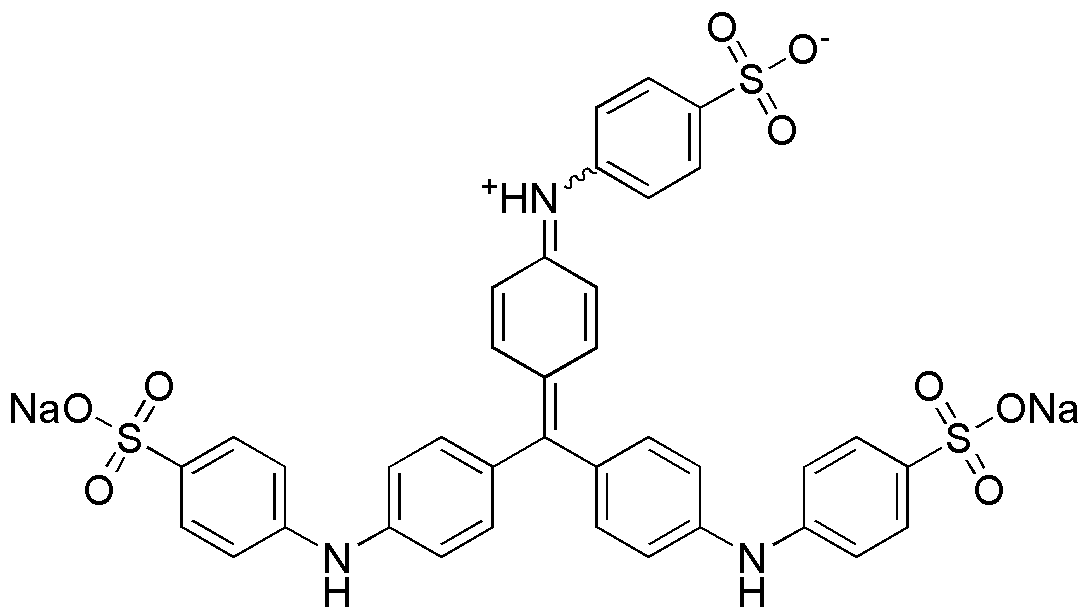Methyl blue is widely utilized in research focused on:
- Biological Staining: Commonly used as a dye in microbiology and histology to stain cells and tissues, enhancing visibility under a microscope. This application is crucial for identifying cellular structures and diagnosing diseases.
- pH Indicator: Acts as a pH indicator in various chemical experiments, changing color to signify acidic or basic conditions. This property is particularly beneficial in educational settings and laboratory experiments where monitoring pH is essential.
- Redox Reactions: Employed in redox titrations due to its ability to undergo color changes based on oxidation states. This makes it a valuable tool for chemists in quantitative analysis and determining the concentration of substances.
- Textile Industry: Used as a dye in the textile industry to color fabrics, providing vibrant shades. Its stability and ease of application make it a preferred choice for manufacturers looking for reliable coloring agents.
- Environmental Monitoring: Applied in assessing water quality, as it can indicate the presence of certain pollutants. This application is vital for environmental scientists and regulatory agencies focused on maintaining safe water standards.
General Information
Properties
Safety and Regulations
Applications
Methyl blue is widely utilized in research focused on:
- Biological Staining: Commonly used as a dye in microbiology and histology to stain cells and tissues, enhancing visibility under a microscope. This application is crucial for identifying cellular structures and diagnosing diseases.
- pH Indicator: Acts as a pH indicator in various chemical experiments, changing color to signify acidic or basic conditions. This property is particularly beneficial in educational settings and laboratory experiments where monitoring pH is essential.
- Redox Reactions: Employed in redox titrations due to its ability to undergo color changes based on oxidation states. This makes it a valuable tool for chemists in quantitative analysis and determining the concentration of substances.
- Textile Industry: Used as a dye in the textile industry to color fabrics, providing vibrant shades. Its stability and ease of application make it a preferred choice for manufacturers looking for reliable coloring agents.
- Environmental Monitoring: Applied in assessing water quality, as it can indicate the presence of certain pollutants. This application is vital for environmental scientists and regulatory agencies focused on maintaining safe water standards.
Documents
Safety Data Sheets (SDS)
The SDS provides comprehensive safety information on handling, storage, and disposal of the product.
Product Specification (PS)
The PS provides a comprehensive breakdown of the product’s properties, including chemical composition, physical state, purity, and storage requirements. It also details acceptable quality ranges and the product's intended applications.
Certificates of Analysis (COA)
Search for Certificates of Analysis (COA) by entering the products Lot Number. Lot and Batch Numbers can be found on a product’s label following the words ‘Lot’ or ‘Batch’.
*Catalog Number
*Lot Number
Certificates Of Origin (COO)
This COO confirms the country where the product was manufactured, and also details the materials and components used in it and whether it is derived from natural, synthetic, or other specific sources. This certificate may be required for customs, trade, and regulatory compliance.
*Catalog Number
*Lot Number
Safety Data Sheets (SDS)
The SDS provides comprehensive safety information on handling, storage, and disposal of the product.
DownloadProduct Specification (PS)
The PS provides a comprehensive breakdown of the product’s properties, including chemical composition, physical state, purity, and storage requirements. It also details acceptable quality ranges and the product's intended applications.
DownloadCertificates of Analysis (COA)
Search for Certificates of Analysis (COA) by entering the products Lot Number. Lot and Batch Numbers can be found on a product’s label following the words ‘Lot’ or ‘Batch’.
*Catalog Number
*Lot Number
Certificates Of Origin (COO)
This COO confirms the country where the product was manufactured, and also details the materials and components used in it and whether it is derived from natural, synthetic, or other specific sources. This certificate may be required for customs, trade, and regulatory compliance.


